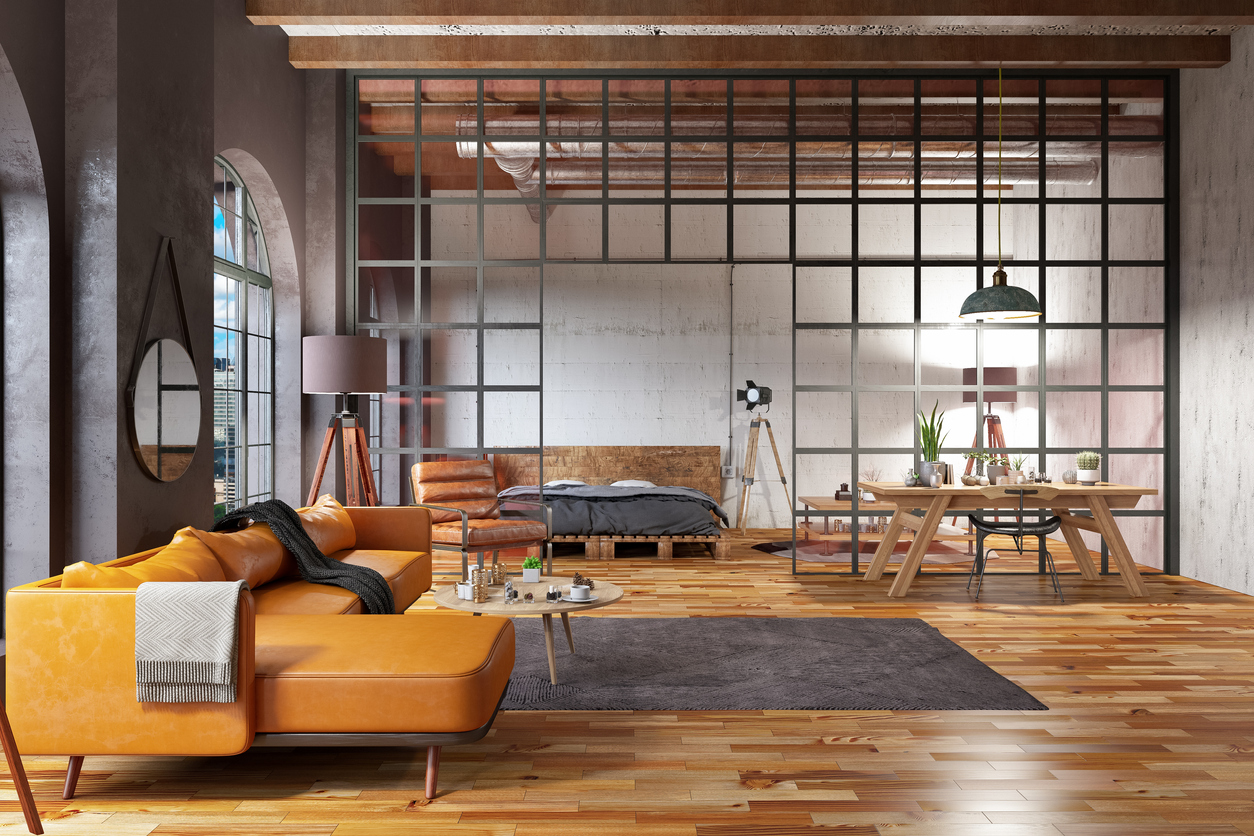

We may earn revenue from the products available on this page and participate in affiliate programs. Learn More ›
Ceilings typically have been an overlooked part of a room makeover, but homeowners are starting to look up and consider options beyond the conventional flat ceiling that’s painted “ceiling white.” Searches for glossy ceilings and painted ceilings are up; tongue-and-groove ceiling searches have risen by 73 percent in the past year, according to a Houzz 2023 summer report.
Style counts for a lot when it comes to a sense of spaciousness, décor decisions, and even the resale value of a home, so adding some design interest to ceilings can go a long way toward capturing attention. Since different ceiling types are best suited to the specific height of a room and the architectural style of the house, read on to explore the pros and cons of nine ceiling styles to help you select what’s right for your dream home.
1. Flat Ceiling

The simplest—and most common—type of ceiling is often finished with drywall and then painted ceiling white. For the past 20 years, those in new homes commonly are 9 feet high and building codes dictate a height of at least 8 feet. For a flat ceiling to stand out, raising it beyond standard height to between 10 and 13 feet can work. Doing this can give rooms and stairwells a brighter, more spacious feel.
Even though they are the most common, flat ceilings aren’t the easiest among the options to install. It takes patience and craft to execute a flawless surface. While most flat ceilings are finished with drywall, some are coated with a thin layer of plaster. It’s the traditional way of finishing walls and ceilings in Great Britain, and prior to drywall, it was traditional in the U.S. as well. Whether skim-coating with drywall tape or covering the entire surface with compound or plaster, it’s important to use a high-quality set of tools. After the surface is ready for paint, most opt for standard ceiling white.
Best for: Minimalist and transitional spaces where homeowners treasure clean lines and simple wall coverings.
Get Glidden Grab-N-Go Pink to White Ceiling Paint at Amazon for 30.97.
RELATED: 9 Clever Ways to Counteract Low Ceilings
2. Drop Ceiling

Also known as a suspended or false ceiling, a drop ceiling is a secondary grid structure that suspends tiles below the main ceiling. Its main purpose is to provide easy access to (and hide) ductwork. Depending on the ceiling panels or tiles that make up a drop ceiling, it also can improve acoustics by buffering noise from water pipes and goings-on in the floor above.
The tiles (typically 2 by 2 or 2 by 4 feet) most often are white, as their original purpose is more about function than fashion, but they are available in colors and patterns, too. Putting in a dropped ceiling requires precision and expertise to avoid interfering with ductwork, pipes, and wiring, so it’s not a DIY-friendly job; professional installation costs approximately $9 to $13 per square foot.
Best for: Rooms that require access to the ceiling, like a basement or media room.
Get Ceilume 2-foot-by-2-foot Black Ceiling Tiles at Amazon for $109.50.
RELATED: 15 Basement Ceiling Ideas to Inspire Your Space
3. Tray Ceiling

A tray ceiling has a raised central inset, and offers an opportunity for dynamic ceiling lighting and playful paint schemes. Typically, the ceiling along the room’s perimeter is at least 9 feet high and flat, with a central section raised about 1 foot higher. These ceilings provide a desirable illusion of height and architectural interest without overly high costs.
While it’s tough to retrofit a home to accommodate a tray ceiling, there are crown moldings with indirect lighting options that mimic the look. In new construction, installing a tray ceiling can cost between $3 to $7 per square foot, depending on home location, room size, and the amount of work required.
Best for: New construction and homes with ceilings that are taller than 10 feet high.
Get Orac Decor Polyurethane Crown Molding at Wayfair for $83.08.
4. Coffered Ceiling

A coffered ceiling features 3D grooved wood or fiberboard panels in a checkerboard pattern that add depth and drama to a space. Their roots reach back to ancient Greece, and this type of ceiling is now often found in grand public buildings as well as large homes.
A minimum ceiling height of 9 feet is required for this striking look, and the expert carpentry and specialized installation process make it pricey—approximately $17 to $60 per square foot, depending on material and such details as carving on the coffers themselves. Those who have decent carpentry skills can make a DIY coffered ceiling for between $250 and $800, depending on room size and material. It’s also possible to create the look of a coffered ceiling by using a coffered dropped ceiling tile system.
Best for: Traditional and formal spaces and rooms with heights reaching greater than 9 feet.
Get Armstrong Ceiling Easy Elegance Black Drop Ceiling Tiles at Lowe’s for $4.18 per square foot.
5. Coved Ceiling

Curved from the wall up to the ceiling, where crown molding usually sits, this ceiling form can lend a comforting vibe to a living room or family room. It can also be combined with a tray ceiling to make a space feel taller and airier.
A builder will charge extra to put in a coved ceiling, since it requires manipulation of the drywall, extra framing, and a level 5 finish that entails skimming the entire surface with compound using a skimming blade. It’s also possible to order a cove kit like this one from Archways and Ceilings. It has rounded edges rather than sharp corners.
Best for: New construction or remodels with ceilings 9 feet tall or more, and for DIYers with ample budgets and patience.
Get the Zozen skimming blade at Amazon for $29.99.
6. Sloped Ceiling

A sloped ceiling rises at an angle, usually following the roofline. These ceilings are found in houses that have a pitched roof, such as Tudors, where the two sides of the roof meet at a peak of finished attic spaces. As a result, the sloped ceilings create cozy nooks inside attic levels directly under the roofline, and increase the airiness of rooms, much like vaulted ceilings.
Homeowners who wish to create one in a renovation or addition should check local building codes, which regulate the minimum height of a sloped ceiling before the space underneath it no longer counts as “living space.” According to the International Residential Code (IRC), a 7-foot ceiling height is required in half of the area of the room.
Finished sloped ceilings are usually covered in drywall and paint. They cost a little more, but similar to the cost for a flat ceiling of the same square footage, since the installation process is similar. However, for attic spaces that have many angles or ceiling beams exposed, the cost can jump quickly. When drywalling a sloped ceiling, it’s helpful to have a panel hoist on hand that can lift the drywall at the correct angle.
Best for: Main space in a one-story home or attic spaces inside pitched roofs.
Get the Troy Professional Drywall and Panel Hoist at The Home Depot for $220.67.
RELATED: Under the Eaves: 21 Arresting Attic Rooms
7. Vaulted Ceiling

Grander than a sloped ceiling, a vaulted ceiling doesn’t follow the slope of the roof, but features a higher central arch that draws attention upward. These central arches are usually built out of wooden scaffolding and finished with a variety of materials, including wood beams, drywall, and tile. Depending on the shape, there are five main types of vaulted ceilings:
• A cathedral ceiling, named for Europe’s grand cathedral interiors, has equal sloping sides and a central point that is higher than the two sides.
• A barrel vault consists of a single curved arch, built under the room’s rafters.
• A groin vault consists of two barrel vaults, intersecting at 90-degree angles, creating four convex (outward-curving) ribs, rising from the corners of the room.
• A cloister vault looks similar to a groin vault, but differs structurally, as the arch rises from the middle of each wall—not the corners—and the ribs are concave, curving inward.
• A domed vault is a vaulted ceiling with a central, circular arch.
Installation costs are determined by the dimensions of the room and any unique engineering issues a contractor might face, but a vaulted ceiling in a typical room can run between $18,000 and $35,000 to install. Be aware that heating and cooling costs can also be more expensive, given the additional height. Plus, lighting mounts will differ for a vaulted ceiling than for a flat ceiling.
Best for: Very large homes, especially grand living rooms and foyers.
Get Halo Sloped Ceiling Recessed Lighting at The Home Depot for $35.65.
RELATED: 6 Things to Know About Living with High Ceilings
8. Exposed Ceiling

An exposed ceiling shows off the beams, pipes, and ductwork typically covered by another type of finished ceiling. Popular in modern industrial interiors, exposed ceilings are intentionally “unfinished,” though all the elements might be painted the same color—like on-trend Tricorn Black (SW 6258) from Sherwin-Williams—for a cohesive look. While an exposed ceiling is an inexpensive option, they typically are noisier from activity above and less insulated (which can increase heating costs).
Best for: Basements and homes with an industrial or modern style.
Get Sherwin-Williams Tricorn Black Paint at Lowe’s for $54.98.
RELATED: 11 Breathtaking Ideas for a Wood Ceiling
9. Beamed Ceiling

Beamed ceilings, in which timber beams are visible, evoke rustic charm. While traditionally found in cabins, chalets, and other homes built of timber with post-and-lintel construction, some of today’s beam ceilings are made up of faux wood beams made of wood, fiberglass, or polyurethane to recreate the look.
Expect to pay 10 to 15 percent more for your home’s ceiling construction if you want genuine exposed wood beams. Keep in mind that true beamed ceilings don’t have as much insulation as other types, and aren’t as energy-efficient as drywall and other finished ceilings.
Best for: Rustic homes, attic spaces, and grand living spaces that have ceiling space for a new wood or faux beam installation.
Get Ornamental Moldings 96-inch-long Unfinished Wood Decorative Beam at Lowe’s for $104.99.
